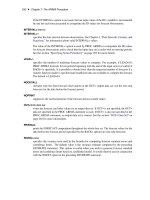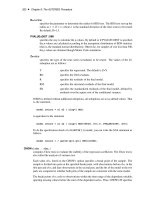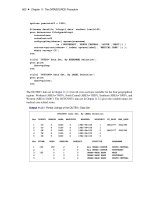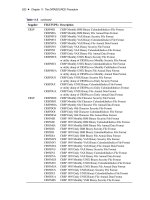SAS/ETS 9.22 User''''s Guide 37 doc
Bạn đang xem bản rút gọn của tài liệu. Xem và tải ngay bản đầy đủ của tài liệu tại đây (277.13 KB, 10 trang )
352 ✦ Chapter 8: The AUTOREG Procedure
D=number
specifies the parameter to determine the radius for BDS test. The BDS test sets up the
radius as
r D D
, where
is the standard deviation of the time series to be tested.
By default, D=1.5.
PVALUE=DIST | SIM
specifies the way to calculate the p-values. By default or if PVALUE=DIST is specified,
the p-values are calculated according to the asymptotic distribution of BDS statistics
(that is, the standard normal distribution). Otherwise, for samples of size less than 500,
the p-values are obtained though Monte Carlo simulation.
Z=value
specifies the type of the time series (residuals) to be tested. The values of the Z=
suboption are as follows:
Y specifies the regressand. The default is Z=Y.
RO specifies the OLS residuals.
R specifies the residuals of the final model.
RM specifies the structural residuals of the final model.
SR
specifies the standardized residuals of the final model, defined by
residuals over the square root of the conditional variance.
If BDS is defined without additional suboptions, all suboptions are set as default values. That
is, the statement
model return = x1 x2 / nlag=1 BDS;
is equivalent to the statement
model return = x1 x2 / nlag=1 BDS=(M=20, D=1.5, PVALUE=DIST, Z=Y);
To do the specification check of a GARCH(1,1) model, you can write the SAS statement as
follows:
model return = / garch=(p=1,q=1) BDS=(Z=SR);
CHOW=( obs
1
. obs
n
)
computes Chow tests to evaluate the stability of the regression coefficient. The Chow test is
also called the analysis-of-variance test.
Each value
obs
i
listed on the CHOW= option specifies a break point of the sample. The
sample is divided into parts at the specified break point, with observations before
obs
i
in the
first part and
obs
i
and later observations in the second part, and the fits of the model in the two
parts are compared to whether both parts of the sample are consistent with the same model.
The break points
obs
i
refer to observations within the time range of the dependent variable,
ignoring missing values before the start of the dependent series. Thus, CHOW=20 specifies
MODEL Statement ✦ 353
the 20th observation after the first nonmissing observation for the dependent variable. For
example, if the dependent variable Y contains 10 missing values before the first observation
with a nonmissing Y value, then CHOW=20 actually refers to the 30th observation in the data
set.
When you specify the break point, you should note the number of presample missing values.
COEF
prints the transformation coefficients for the first p observations. These coefficients are
formed from a scalar multiplied by the inverse of the Cholesky root of the Toeplitz matrix of
autocovariances.
CORRB
prints the estimated correlations of the parameter estimates.
COVB
prints the estimated covariances of the parameter estimates.
COVEST=OP | HESSIAN | QML
specifies the type of covariance matrix for the GARCH or heteroscedasticity model. When
COVEST=OP is specified, the outer product matrix is used to compute the covariance matrix
of the parameter estimates. The COVEST=HESSIAN option produces the covariance matrix
by using the Hessian matrix. The quasi-maximum likelihood estimates are computed with
COVEST=QML. The default is COVEST=OP.
DW=n
prints Durbin-Watson statistics up to the order n. The default is DW=1. When the LAGDEP
option is specified, the Durbin-Watson statistic is not printed unless the DW= option is
explicitly specified.
DWPROB
now produces p-values for the generalized Durbin-Watson test statistics for large sample sizes.
Previously, the Durbin-Watson probabilities were calculated only for small sample sizes. The
new method of calculating Durbin-Watson probabilities is based on the algorithm of Ansley,
Kohn, and Shively (1992).
GINV
prints the inverse of the Toeplitz matrix of autocovariances for the Yule-Walker solution. See
the section “Computational Methods” on page 372 later in this chapter for details.
GODFREY
GODFREY=r
produces Godfrey’s general Lagrange multiplier test against ARMA errors.
ITPRINT
prints the objective function and parameter estimates at each iteration. The objective function
is the full log likelihood function for the maximum likelihood method, while the error sum
of squares is produced as the objective function of unconditional least squares. For the ML
method, the ITPRINT option prints the value of the full log likelihood function, not the
concentrated likelihood.
354 ✦ Chapter 8: The AUTOREG Procedure
LAGDEP
LAGDV
prints the Durbin t statistic, which is used to detect residual autocorrelation in the presence of
lagged dependent variables. See the section “Generalized Durbin-Watson Tests” on page 398
later in this chapter for details.
LAGDEP=name
LAGDV=name
prints the Durbin h statistic for testing the presence of first-order autocorrelation when regres-
sors contain the lagged dependent variable whose name is specified as LAGDEP=name. If
the Durbin h statistic cannot be computed, the asymptotically equivalent t statistic is printed
instead. See the section “Generalized Durbin-Watson Tests” on page 398 for details.
When the regression model contains several lags of the dependent variable, specify the lagged
dependent variable for the smallest lag in the LAGDEP= option. For example:
model y = x1 x2 ylag2 ylag3 / lagdep=ylag2;
LOGLIKL
prints the log likelihood value of the regression model, assuming normally distributed errors.
NOPRINT
suppresses all printed output.
NORMAL
specifies the Jarque-Bera’s normality test statistic for regression residuals.
PARTIAL
prints partial autocorrelations.
PCHOW=( obs
1
. obs
n
)
computes the predictive Chow test. The form of the PCHOW= option is the same as the
CHOW= option; see the discussion of the CHOW= option earlier in this chapter.
RESET
produces Ramsey’s RESET test statistics. The RESET option tests the null model
y
t
D x
t
ˇ Cu
t
against the alternative
y
t
D x
t
ˇ C
p
X
j D2
j
Oy
j
t
C u
t
where
Oy
t
is the predicted value from the OLS estimation of the null model. The RESET option
produces three RESET test statistics for p D 2, 3, and 4.
MODEL Statement ✦ 355
RUNS
RUNS=(Z=value)
specifies the runs test for independence. The Z= suboption specifies the type of the time series
or residuals to be tested. The values of the Z= suboption are as follows:
Y specifies the regressand. The default is Z=Y.
RO specifies the OLS residuals.
R specifies the residuals of the final model.
RM specifies the structural residuals of the final model.
SR
specifies the standardized residuals of the final model, defined by residuals
over the square root of the conditional variance.
STATIONARITY=( ADF)
STATIONARITY=( ADF=( value . . . value ) )
STATIONARITY=( KPSS )
STATIONARITY=( KPSS=( KERNEL=type ) )
STATIONARITY=( KPSS=( KERNEL=type TRUNCPOINTMETHOD) )
STATIONARITY=( PHILLIPS )
STATIONARITY=( PHILLIPS=( value . . . value ) )
STATIONARITY=( ERS)
Experimental
STATIONARITY=( ERS=( value ) )
STATIONARITY=( NP)
STATIONARITY=( NP=( value ) )
STATIONARITY=( ADF<=(. . . )>,ERS<=(. . . )>, KPSS<=(. . . )>, NP<=(. . . )>, PHILLIPS<=(. . . )> )
specifies tests of stationarity or unit roots. The STATIONARITY= option provides Phillips-
Perron, Phillips-Ouliaris, augmented Dickey-Fuller, Engle-Granger, KPSS, ERS, and NP
tests.
The PHILLIPS or PHILLIPS= suboption of the STATIONARITY= option produces the
Phillips-Perron unit root test when there are no regressors in the MODEL statement. When the
model includes regressors, the PHILLIPS option produces the Phillips-Ouliaris cointegration
test. The PHILLIPS option can be abbreviated as PP.
The PHILLIPS option performs the Phillips-Perron test for three null hypothesis cases: zero
mean, single mean, and deterministic trend. For each case, the PHILLIPS option computes two
test statistics,
O
Z
and
O
Z
t
(in the original paper they are referred to as
O
Z
˛
and
O
Z
t
) , and reports
their p-values. These test statistics have the same limiting distributions as the corresponding
Dickey-Fuller tests.
The three types of the Phillips-Perron unit root test reported by the PHILLIPS option are as
follows:
356 ✦ Chapter 8: The AUTOREG Procedure
Zero mean
computes the Phillips-Perron test statistic based on the zero mean autore-
gressive model:
y
t
D y
t1
C u
t
Single mean
computes the Phillips-Perron test statistic based on the autoregressive model
with a constant term:
y
t
D C y
t1
C u
t
Trend
computes the Phillips-Perron test statistic based on the autoregressive model
with constant and time trend terms:
y
t
D C y
t1
C ıt C u
t
You can specify several truncation points
l
for weighted variance estimators by using the
PHILLIPS=(l
1
: : :l
n
) specification. The statistic for each truncation point l is computed as
2
T l
D
1
T
T
X
iD1
Ou
2
i
C
2
T
l
X
sD1
w
sl
T
X
tDsC1
Ou
t
Ou
ts
where
w
sl
D 1 s=.l C 1/
and
Ou
t
are OLS residuals. If you specify the PHILLIPS option
without specifying truncation points, the default truncation point is
max.1;
p
T =5/
, where
T
is the number of observations.
The Phillips-Perron test can be used in general time series models since its limiting distribution
is derived in the context of a class of weakly dependent and heterogeneously distributed
data. The marginal probability for the Phillips-Perron test is computed assuming that error
disturbances are normally distributed.
When there are regressors in the MODEL statement, the PHILLIPS option computes the
Phillips-Ouliaris cointegration test statistic by using the least squares residuals. The normalized
cointegrating vector is estimated using OLS regression. Therefore, the cointegrating vector
estimates might vary with the regressand (normalized element) unless the regression R-square
is 1.
The marginal probabilities for cointegration testing are not produced. You can refer to Phillips
and Ouliaris (1990) tables Ia–Ic for the
O
Z
˛
test and tables IIa–IIc for the
O
Z
t
test. The standard
residual-based cointegration test can be obtained using the NOINT option in the MODEL
statement, while the demeaned test is computed by including the intercept term. To obtain the
demeaned and detrended cointegration tests, you should include the time trend variable in the
regressors. Refer to Phillips and Ouliaris (1990) or Hamilton (1994, Tbl. 19.1) for information
about the Phillips-Ouliaris cointegration test. Note that Hamilton (1994, Tbl. 19.1) uses
Z
and
Z
t
instead of the original Phillips and Ouliaris (1990) notation. We adopt the notation
introduced in Hamilton. To distinguish from Student’s
t
distribution, these two statistics are
named accordingly as (rho) and (tau).
The ADF or ADF= suboption produces the augmented Dickey-Fuller unit root test (Dickey
and Fuller 1979). As in the Phillips-Perron test, three regression models can be specified for
the null hypothesis for the augmented Dickey-Fuller test (zero mean, single mean, and trend).
MODEL Statement ✦ 357
These models assume that the disturbances are distributed as white noise. The augmented
Dickey-Fuller test can account for the serial correlation between the disturbances in some way.
The model, with the time trend specification for example, is
y
t
D C y
t1
C ıt C
1
y
p1
C : : : C
p
y
tp
C u
t
This formulation has the advantage that it can accommodate higher-order autoregressive
processes in
u
t
. The test statistic follows the same distribution as the Dickey-Fuller test
statistic. For more information, see the section “PROBDF Function for Dickey-Fuller Tests”
on page 162.
In the presence of regressors, the ADF option tests the cointegration relation between the
dependent variable and the regressors. Following Engle and Granger (1987), a two-step
estimation and testing procedure is carried out, in a fashion similar to the Phillips-Ouliaris
test. The OLS residuals of the regression in the MODEL statement are used to compute the t
statistic of the augmented Dickey-Fuller regression in a second step. Three cases arise based
on which type of deterministic terms are included in the first step of regression. Only the
constant term and linear trend cases are practically useful (Davidson and MacKinnon 1993,
page 721), and therefore are computed and reported. The test statistic, as shown in Phillips
and Ouliaris (1990), follows the same distribution as the
O
Z
t
statistic in the Phillips-Ouliaris
cointegration test. The asymptotic distribution is tabulated in tables IIa–IIc of Phillips and
Ouliaris (1990), and the finite sample distribution is obtained in Table 2 and Table 3 in Engle
and Yoo (1987) by Monte Carlo simulation.
The experimental ERS or ERS= suboption and NP or NP= suboption provide a class of efficient
unit root tests, in the sense that they reduce the size distortion and improve the power compared
with traditional unit root tests such as augmented Dickey-Fuller and Phillips-Perron tests. Two
test statistics are provided by the ERS test: the point optimal test and the DF-GLS test, which
are originally proposed in Elliott, Rothenberg, and Stock (1996). Four different tests, discussed
in Ng and Perron (2001), are reported by NP test. These four tests include the two in the ERS
test and two other tests, the modified PP test and the modified point optimal test, discussed
in Ng and Perron (2001). The authors suggest using the modified AIC to select the optimal
lag length in the augmented Dickey-Fuller type regression. The maximum lag length can be
provided by using the NP= suboption. The default maximum lag length is 8.
The KPSS, KPSS=(KERNEL=TYPE), or KPSS=(KERNEL=TYPE TRUNCPOINT-
METHOD) specifications of the STATIONARITY= option produce the Kwiatkowski,
Phillips, Schmidt, and Shin (1992) (KPSS) unit root test.
Unlike the null hypothesis of the Dickey-Fuller and Phillips-Perron tests, the null hypothesis of
the KPSS states that the time series is stationary. As a result, it tends to reject a random walk
more often. If the model does not have an intercept, the KPSS option performs the KPSS test
for three null hypothesis cases: zero mean, single mean, and deterministic trend. Otherwise, it
reports the single mean and deterministic trend only. It computes a test statistic and provides
tabulated critical values (see Hobijn, Franses, and Ooms (2004)) for the hypothesis that the
random walk component of the time series is equal to zero in the following cases (for details,
see “Kwiatkowski, Phillips, Schmidt, and Shin (KPSS) Unit Root Test” on page 393):
358 ✦ Chapter 8: The AUTOREG Procedure
Zero mean
computes the KPSS test statistic based on the zero mean autoregressive
model. The p-value reported is used from Hobijn, Franses, and Ooms
(2004).
y
t
D u
t
Single mean
computes the KPSS test statistic based on the autoregressive model with
a constant term. The p-value reported is used from Kwiatkowski et al.
(1992).
y
t
D C u
t
Trend
computes the KPSS test statistic based on the autoregressive model with
constant and time trend terms. The p-value reported is from Kwiatkowski
et al. (1992).
y
t
D C ıt C u
t
This test depends on the long-run variance of the series being defined as
2
T l
D
1
T
T
X
iD1
Ou
2
i
C
2
T
l
X
sD1
w
sl
T
X
tDsC1
Ou
t
Ou
ts
where
w
sl
is a kernel,
s
is a maximum lag (truncation point), and
Ou
t
are OLS residuals or
original data series. You can specify two types of the kernel:
KERNEL=NW | BART Newey-West (or Bartlett) kernel
w.s; l/ D 1
s
l C 1
KERNEL=QS Quadratic spectral kernel
w.s=l/ D w.x/ D
25
12
2
x
2
Â
sin
.
6x=5
/
6x=5
cos
.
6x=5
/
Ã
You can set the truncation point s by using three different methods:
SCHW=c Schwert maximum lag formula
s D max
(
1; floor
"
c
Â
T
100
Ã
1=4
#)
LAG=s LAG=s manually defined number of lags.
AUTO
Automatic bandwidth selection (Hobijn, Franses, and Ooms 2004) (for
details, see “Kwiatkowski, Phillips, Schmidt, and Shin (KPSS) Unit Root
Test” on page 393).
MODEL Statement ✦ 359
If STATIONARITY=KPSS is defined without additional parameters, the Newey-West kernel
is used. For the Newey-West kernel the default is the Schwert truncation point method with
c D 4. For the quadratic spectral kernel the default is AUTO.
The KPSS test can be used in general time series models since its limiting distribution is
derived in the context of a class of weakly dependent and heterogeneously distributed data.
The limiting probability for the KPSS test is computed assuming that error disturbances are
normally distributed.
The asymptotic distribution of the test does not depend on the presence of regressors in the
MODEL statement.
The marginal probabilities for the test are reported. They are copied from Kwiatkowski et al.
(1992) and Hobijn, Franses, and Ooms (2004). When there is an intercept in the model, results
for mean and trend tests statistics are provided.
Examples: To test for stationarity of regression residuals, using default KERNEL= NW and
SCHW= 4, you can use the following code:
/
*
test for stationarity of regression residuals
*
/
proc autoreg data=a;
model y= / stationarity = (KPSS);
run;
To test for stationarity of regression residuals, using quadratic spectral kernel and automatic
bandwidth selection, you can use:
/
*
test for stationarity using quadratic
spectral kernel and automatic bandwidth selection
*
/
proc autoreg data=a;
model y= /
stationarity = (KPSS=(KERNEL=QS AUTO));
run;
TP
TP=(Z=value)
specifies the turning point test for independence. The Z= suboption specifies the type of the
time series or residuals to be tested. The values of the Z= suboption are as follows:
Y specifies the regressand. The default is Z=Y.
RO specifies the OLS residuals.
R specifies the residuals of the final model.
RM specifies the structural residuals of the final model.
SR
specifies the standardized residuals of the final model, defined by residuals
over the square root of the conditional variance.
URSQ
prints the uncentered regression
R
2
. The uncentered regression
R
2
is useful to compute
360 ✦ Chapter 8: The AUTOREG Procedure
Lagrange multiplier test statistics, since most LM test statistics are computed as T *URSQ,
where T is the number of observations used in estimation.
VNRRANK
VNRRANK=(option-list)
specifies the rank version of the von Neumann ratio test for independence. The following
options can be used in the VNRRANK=( ) option. The options are listed within parentheses
and separated by commas.
PVALUE=DIST | SIM
specifies the way to calculate the p-value. By default or if PVALUE=DIST is specified,
the p-value is calculated according to the asymptotic distribution of the statistic (that
is, the standard normal distribution). Otherwise, for samples of size less than 100, the
p-value is obtained though Monte Carlo simulation.
Z=value
specifies the type of the time series or residuals to be tested. The values of the Z=
suboption are as follows:
Y specifies the regressand. The default is Z=Y.
RO specifies the OLS residuals.
R specifies the residuals of the final model.
RM specifies the structural residuals of the final model.
SR
specifies the standardized residuals of the final model, defined by
residuals over the square root of the conditional variance.
Stepwise Selection Options
BACKSTEP
removes insignificant autoregressive parameters. The parameters are removed in order of
least significance. This backward elimination is done only once on the Yule-Walker estimates
computed after the initial ordinary least squares estimation. The BACKSTEP option can
be used with all estimation methods since the initial parameter values for other estimation
methods are estimated using the Yule-Walker method.
SLSTAY=value
specifies the significance level criterion to be used by the BACKSTEP option. The default is
SLSTAY=.05.
Estimation Control Options
CONVERGE=value
specifies the convergence criterion. If the maximum absolute value of the change in the autore-
gressive parameter estimates between iterations is less than this amount, then convergence is
assumed. The default is CONVERGE=.001.
MODEL Statement ✦ 361
If the GARCH= option and/or the HETERO statement is specified, convergence is assumed
when the absolute maximum gradient is smaller than the value specified by the CONVERGE=
option or when the relative gradient is smaller than 1E–8. By default, CONVERGE=1E–5.
INITIAL=( initial-values )
START=( initial-values )
specifies initial values for some or all of the parameter estimates. The values specified are
assigned to model parameters in the same order as the parameter estimates are printed in
the AUTOREG procedure output. The order of values in the INITIAL= or START= option
is as follows: the intercept, the regressor coefficients, the autoregressive parameters, the
ARCH parameters, the GARCH parameters, the inverted degrees of freedom for Student’s
t distribution, the start-up value for conditional variance, and the heteroscedasticity model
parameters Á specified by the HETERO statement.
The following is an example of specifying initial values for an AR(1)-GARCH
.1; 1/
model
with regressors X1 and X2:
/
*
specifying initial values
*
/
model y = w x / nlag=1 garch=(p=1,q=1)
initial=(1 1 1 .5 .8 .1 .6);
The model specified by this MODEL statement is
y
t
D ˇ
0
C ˇ
1
w
t
C ˇ
2
x
t
C
t
t
D
t
1
t1
t
D
p
h
t
e
t
h
t
D ! C˛
1
2
t1
C
1
h
t1
t
N.0;
2
t
/
The initial values for the regression parameters, INTERCEPT (
ˇ
0
), X1 (
ˇ
1
), and X2 (
ˇ
2
), are
specified as 1. The initial value of the AR(1) coefficient (
1
) is specified as 0.5. The initial
value of ARCH0 (
!
) is 0.8, the initial value of ARCH1 (
˛
1
) is 0.1, and the initial value of
GARCH1 (
1
) is 0.6.
When you use the RESTRICT statement, the initial values specified by the INITIAL= option
should satisfy the restrictions specified for the parameter estimates. If they do not, the initial
values you specify are adjusted to satisfy the restrictions.
LDW
specifies that p-values for the Durbin-Watson test be computed using a linearized approxima-
tion of the design matrix when the model is nonlinear due to the presence of an autoregressive
error process. (The Durbin-Watson tests of the OLS linear regression model residuals are not
affected by the LDW option.) Refer to White (1992) for Durbin-Watson testing of nonlinear
models.
MAXITER=number
sets the maximum number of iterations allowed. The default is MAXITER=50.









